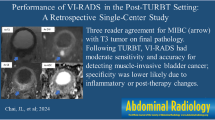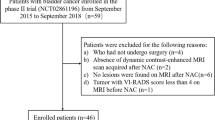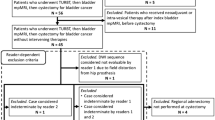Abstract
Objectives
To evaluate accuracy and inter-observer variability using Vesical Imaging-Reporting and Data System (VI-RADS) for discrimination between non-muscle invasive bladder cancer (NMIBC) and muscle-invasive bladder cancer (MIBC).
Methods
Between September 2017 and July 2018, 78 patients referred for suspected bladder cancer underwent multiparametric MRI of the bladder (mpMRI) prior to transurethral resection of bladder tumor (TURBT). All mpMRI were reviewed by two radiologists, who scored each lesion according to VI-RADS. Sensitivity, specificity, positive predictive value (PPV), and negative predictive value (NPV) were calculated for each VI-RADS cutoff. Receiver operating characteristics curves were used to evaluate the performance of mpMRI. The Ƙ statistics was used to estimate inter-reader agreement.
Results
Seventy-five patients were included in the final analysis, 53 with NMIBC and 22 with MIBC. Sensitivity and specificity were 91% and 89% for reader 1 and 82% and 85% for reader 2 respectively when the cutoff VI-RADS > 2 was used to define MIBC. At the same cutoff, PPV and NPV were 77% and 96% for reader 1 and 69% and 92% for reader 2. When the cutoff VI-RADS > 3 was used, sensitivity and specificity were 82% and 94% for reader 1 and 77% and 89% for reader 2. Corresponding PPV and NPV were 86% and 93% for reader 1 and 74% and 91% for reader 2. Area under curve was 0.926 and 0.873 for reader 1 and 2 respectively. Inter-reader agreement was good for the overall score (Ƙ = 0.731).
Conclusions
VI-RADS is accurate in differentiating MIBC from NMIBC. Inter-reader agreement is overall good.
Key Points
• Traditionally, the local staging of bladder cancer relies on transurethral resection of bladder tumor.
• However, transurethral resection of bladder tumor carries a significant risk of understaging a cancer; therefore, more accurate, faster, and non-invasive staging techniques are needed to improve outcomes.
• Multiparametric MRI has proved to be the best imaging modality for local staging; therefore, its use in suitable patients has the potential to expedite radical treatment when necessary and non-invasive diagnosis in patients with poor fitness.





Similar content being viewed by others
Abbreviations
- ADC:
-
Apparent diffusion coefficient
- AUC:
-
Area under curve
- BCa:
-
Bladder cancer
- DCE-MRI:
-
Dynamic contrast-enhanced MRI
- DWI:
-
Diffusion-weighted imaging
- MIBC:
-
Muscle-invasive bladder cancer
- mpMRI:
-
Multiparametric MRI of the prostate
- NMIBC:
-
Non-muscle-invasive bladder cancer
- ROC:
-
Receiver operating characteristics
- TURBT:
-
Transurethral resection of bladder tumor
- VI-RADS:
-
Vesical Imaging-Reporting and Data System
References
Siegel RL, Miller KD, Jemal A (2018) Cancer statistics, 2018. CA Cancer J Clin 68:7–30
Cumberbatch MGK, Jubber I, Black PC et al (2018) Epidemiology of bladder cancer: a systematic review and contemporary update of risk factors in 2018. Eur Urol 74:784–795
Marcos-Gragera R, Mallone S, Kiemeney LA et al (2015) Urinary tract cancer survival in Europe 1999-2007: results of the population-based study EUROCARE-5. Eur J Cancer 51:2217–2230
Soukup V, Capoun O, Cohen D et al (2017) Prognostic performance and reproducibility of the 1973 and 2004/2016 World Health Organization grading classification systems in non-muscle-invasive bladder cancer: a European Association of Urology non-muscle invasive bladder cancer guidelines panel syst. Eur Urol 72:801–813
Witjes JA, Comperat E, Cowan NC et al (2014) EAU guidelines on muscle-invasive and metastatic bladder cancer: summary of the 2013 guidelines. Eur Urol 65:778–792
Babjuk M, Böhle A, Burger M et al (2017) EAU guidelines on non-muscle-invasive urothelial carcinoma of the bladder: update 2016. Eur Urol 71:447–461
Gendy R, Delprado W, Brenner P et al (2016) Repeat transurethral resection for non-muscle-invasive bladder cancer: a contemporary series. BJU Int 117(Suppl):54–59
Klaassen Z, Kamat AM, Kassouf W et al (2018) Treatment strategy for newly diagnosed T1 high-grade bladder urothelial carcinoma: new insights and updated recommendations. Eur Urol 74:597–608
van der Pol CB, Sahni VA, Eberhardt SC et al (2018) ACR appropriateness criteria® pretreatment staging of muscle-invasive bladder cancer. J Am Coll Radiol 15:S150–S159
Gandhi N, Krishna S, Booth CM, et al (2018) Diagnostic accuracy of magnetic resonance imaging for tumour staging of bladder cancer: systematic review and meta-analysis. BJU Int 122:744–753. https://doi.org/10.1111/bju.14366
Woo S, Suh CH, Kim SY et al (2017) Diagnostic performance of MRI for prediction of muscle-invasiveness of bladder cancer: a systematic review and meta-analysis. Eur J Radiol 95:46–55
Panebianco V, Narumi Y, Altun E et al (2018) Multiparametric magnetic resonance imaging for bladder cancer: development of VI-RADS (Vesical Imaging-Reporting And Data System). Eur Urol 74:294-306. https://doi.org/10.1016/j.eururo.2018.04.029
Weinreb JC, Barentsz JO, Choyke PL et al (2016) PI-RADS prostate imaging - reporting and data system: 2015, version 2. Eur Urol 69:16–40
Muller BG, Shih JH, Sankineni S et al (2015) Prostate cancer: interobserver agreement and accuracy with the revised prostate imaging reporting and data system at multiparametric MR imaging. Radiology 277:741–750
Wang H, Pui MH, Guo Y et al (2015) Multiparametric 3-T MRI for differentiating low-versus high-grade and category T1 versus T2 bladder urothelial carcinoma. AJR Am J Roentgenol 204:330–334
Panebianco V, De Berardinis E, Barchetti G et al (2017) An evaluation of morphological and functional multi-parametric MRI sequences in classifying non-muscle and muscle invasive bladder cancer. Eur Radiol 27(9):3759–3766
Takeuchi M, Sasaki S, Ito M et al (2009) Urinary bladder cancer: diffusion-weighted MR imaging--accuracy for diagnosing T stage and estimating histologic grade. Radiology 251:112–121
Wang H-J, Pui MH, Guan J et al (2016) Comparison of early submucosal enhancement and tumor stalk in staging bladder urothelial carcinoma. AJR Am J Roentgenol 207:797–803. https://doi.org/10.2214/AJR.16.16283
Huang L, Kong Q, Liu Z et al (2018) The diagnostic value of MR imaging in differentiating T staging of bladder cancer: a meta-analysis. Radiology 286:502–511
Shariat SF, Palapattu GS, Karakiewicz PI et al (2007) Discrepancy between clinical and pathologic stage: impact on prognosis after radical cystectomy. Eur Urol 51:137–151
Hollenbeck BK, Ye Z, Dunn RL et al (2009) Provider treatment intensity and outcomes for patients with early-stage bladder cancer. J Natl Cancer Inst 101:571–580
van der Pol CB, Shinagare AB, Tirumani SH et al (2018) Bladder cancer local staging: multiparametric MRI performance following transurethral resection. Abdom Radiol (NY). https://doi.org/10.1007/s00261-017-1449-0
Necchi A, Messina A, Briganti A (2018) Re: Valeria Panebianco, Yoshifumi Narumi, Ersan Altun, et al Multiparametric magnetic resonance imaging for bladder cancer: development of VI-RADS (Vesical Imaging-Reporting And Data System). Eur Urol. https://doi.org/10.1016/j.eururo.2018.04.0
Crozier J, Papa N, Perera M et al (2018) Comparative sensitivity and specificity of imaging modalities in staging bladder cancer prior to radical cystectomy: a systematic review and meta-analysis. World J Urol. https://doi.org/10.1007/s00345-018-2439-8
Funding
The authors state that this work has not received any funding.
Author information
Authors and Affiliations
Corresponding author
Ethics declarations
Guarantor
The scientific guarantor of this publication is Valeria Panebianco.
Conflict of interest
The authors of this manuscript declare no relationships with any companies, whose products or services may be related to the subject matter of the article.
Statistics and biometry
One of the authors has significant statistical expertise.
Informed consent
Written informed consent was waived by the Institutional Review Board.
Ethical approval
Institutional Review Board approval was obtained.
Methodology
• retrospective
• diagnostic or prognostic study
• performed at one institution
Additional information
Publisher’s note
Springer Nature remains neutral with regard to jurisdictional claims in published maps and institutional affiliations.
Electronic supplementary material
ESM 1
(DOCX 3750 kb)
Rights and permissions
About this article
Cite this article
Barchetti, G., Simone, G., Ceravolo, I. et al. Multiparametric MRI of the bladder: inter-observer agreement and accuracy with the Vesical Imaging-Reporting and Data System (VI-RADS) at a single reference center. Eur Radiol 29, 5498–5506 (2019). https://doi.org/10.1007/s00330-019-06117-8
Received:
Revised:
Accepted:
Published:
Issue Date:
DOI: https://doi.org/10.1007/s00330-019-06117-8




